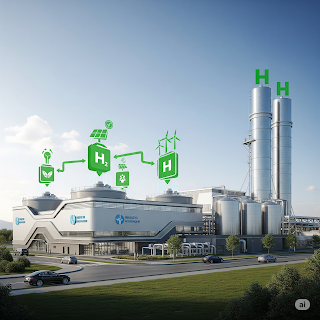🟩 Key Takeaways
📌 Green hydrogen from waste is emerging as a sustainable fuel alternative, reducing landfill waste and cutting carbon emissions.
📌 Technologies like plasma gasification and anaerobic digestion are driving innovation in waste-to-hydrogen projects.
📌 India, Japan, and the EU are investing in municipal waste-to-hydrogen plants as part of their green energy targets.
📌 These projects tackle two crises at once: waste overload and clean energy demand.
📌 The economic potential is vast, but requires policy support and infrastructure development.
🟢 Why Waste to Hydrogen?
As nations worldwide race toward net-zero emissions, green hydrogen has emerged as a promising clean fuel. What’s even more innovative? Producing it from organic and municipal waste.
By converting everyday garbage into a clean fuel, these projects address two critical issues simultaneously—mounting waste and rising carbon emissions.
🔍 What is Green Hydrogen?
Green hydrogen is produced using renewable energy sources like solar and wind, typically through water electrolysis. Unlike grey or blue hydrogen, it emits no greenhouse gases.
But waste-derived hydrogen takes this a step further—by using biodegradable waste as the input material for generating hydrogen.
🏭 How Does Waste-to-Hydrogen Technology Work?
There are several cutting-edge technologies that convert waste into green hydrogen:
1. Plasma Gasification
-
High-temperature plasma torches break down waste into syngas.
-
The syngas is further refined to isolate hydrogen.
2. Anaerobic Digestion
-
Organic waste (like food and sewage) is broken down by microbes.
-
Methane produced is reformed into hydrogen.
3. Steam Reforming of Biogas
-
A cleaner alternative to fossil-fuel-based steam reforming.
-
Utilizes methane from biodegradable sources.
🌏 Real-World Examples and Global Initiatives
🇮🇳 India’s Push for Hydrogen from Waste
-
Indian Oil Corporation and NTPC are testing waste-to-hydrogen pilots.
-
Cities like Indore and Pune are exploring scalable models using municipal solid waste.
🇯🇵 Japan’s Hydrogen Vision
-
Facilities in Tokyo convert food waste and sludge into hydrogen to power fuel-cell buses.
🇪🇺 EU and Horizon Europe Projects
-
Multiple EU-funded waste-to-hydrogen demonstration plants are underway.
💰 Economic and Environmental Benefits
✅ Dual Problem Solver
-
Reduces landfill burden and methane emissions.
-
Offers clean energy for transport and industrial use.
✅ Rural and Urban Employment
-
Waste collection, processing, and plant operations create green jobs.
✅ Grid Independence
-
Localized hydrogen generation can power off-grid regions.
⚠️ Challenges Ahead
-
High capital costs of technology deployment.
-
Need for supply chain integration for waste segregation.
-
Lack of robust waste management laws in many countries.
-
Public awareness and political will are crucial for success.
🚀 The Road Ahead
With the global green hydrogen market projected to hit $300 billion by 2030, waste-to-hydrogen could become a central pillar in future energy systems—especially for developing nations.
Governments, industries, and research institutions must work together to scale pilot projects, build infrastructure, and create policy incentives.
📝 Conclusion
Turning waste into green hydrogen is no longer a far-fetched concept—it’s here, and it works. As technologies mature and pilot projects prove their value, we may soon find that our trash truly is tomorrow’s treasure.


No comments:
Post a Comment